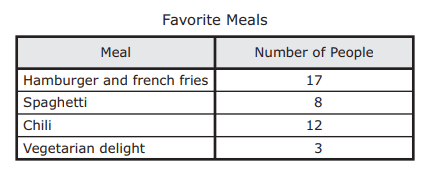
7.6.H Solve problems using qualitative qnd quantitative predictions/comparisons
Quiz by Grade 7 Math - Texas Education Agency
Grade 7
Math (Archived)
Texas Essential Knowledge and Skills (TEKS)
Feel free to use or edit a copy
includes Teacher and Student dashboards
Measures 1 skill from
Measures 1 skill from
Track each student's skills and progress in your Mastery dashboards
With a free account, teachers can
- edit the questions
- save a copy for later
- start a class game
- automatically assign follow-up activities based on students’ scores
- assign as homework
- share a link with colleagues
- print as a bubble sheet
5 questions
Show answers
- Q1Deborah surveyed customers in a restaurant to find out their favorite meal. The results of the survey are shown in the table. One person in the restaurant will be picked at random. Based on the given information, which statement is true?This person’s favorite meal is four times as likely to be chili as it is to be vegetarian delight.This person’s favorite meal is twice as likely to be hamburger and french fries as it is to be spaghetti.This person’s favorite meal is equally likely to be either vegetarian delight or spaghetti.This person’s favorite meal is four times as likely to be chili as it is to be vegetarian delight.60s7.6.H: Proportionality
- Q2A store manager receives a delivery of 2 boxes of lightbulbs. Each box contains 25 lightbulbs. The store manager tests all the lightbulbs and finds that 2 of them are defective. Based on these results, what can the store manager predict about the next delivery of lightbulbs?A delivery of 5 boxes will contain 10 more defective lightbulbs than a delivery of 2 boxes.A delivery of 4 boxes will contain 2 more defective lightbulbs than a delivery of 2 boxes.A delivery of 6 boxes will contain 3 more defective lightbulbs than a delivery of 2 boxes.A delivery of 3 boxes will contain 3 more defective lightbulbs than a delivery of 2 boxes.60s7.6.H: Proportionality
- Q3Felix has a bucket of golf balls. The table shows the number of golf balls of each color in the bucket. Felix selects a golf ball at random. Based on the information in the table, which statement is true?The golf ball is 2 times as likely to be orange as it is to be pink.The golf ball is equally likely to be pink, white, orange, or green.The golf ball is more likely to be green than all other colors combined.The golf ball is 7 times as likely to be green as it is to be white.60s7.6.H: Proportionality
- Q4Mari bought 6 packets of tomato seeds. Each packet contained 24 seeds. She planted 1 packet of the seeds, and 15 seeds sprouted.Which statement about the seeds in the remaining packets is best supported by this information?Between 50 and 100 seeds will sprout.All 120 seeds will sproutAt least 100 but no more than 120 seeds will sprout.No more than 50 seeds will sprout.60s7.6.H: Proportionality
- Q5Leticia has two bouquets of flowers. Each bouquet contains 13 daisies. • Bouquet S contains 30 flowers. • Bouquet T contains 13 flowers. Which statement is true?The probability of randomly selecting a daisy from Bouquet S is 1.The probability of randomly selecting a daisy from Bouquet S is less than the probability of randomly selecting a daisy from Bouquet T.The probability of randomly selecting a daisy from Bouquet S is equal to the probability of randomly selecting a daisy from Bouquet T.The probability of randomly selecting a daisy from Bouquet S is 1/360s7.6.H: Proportionality
